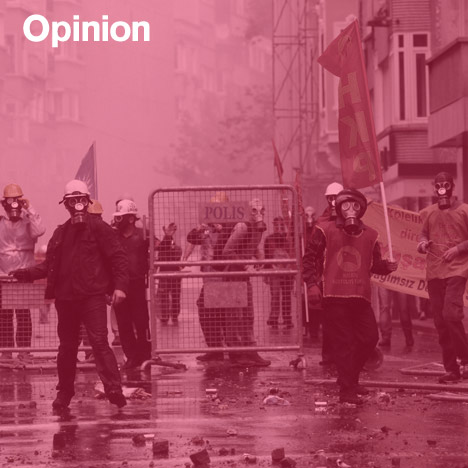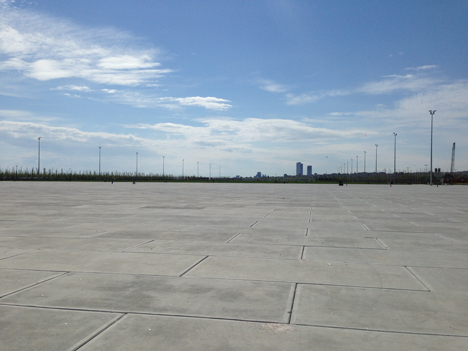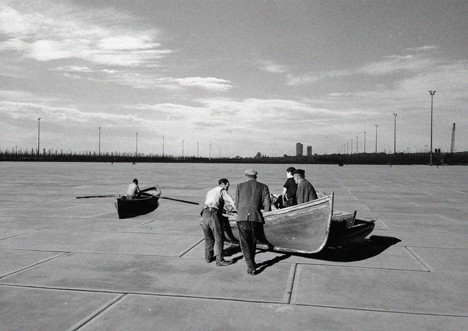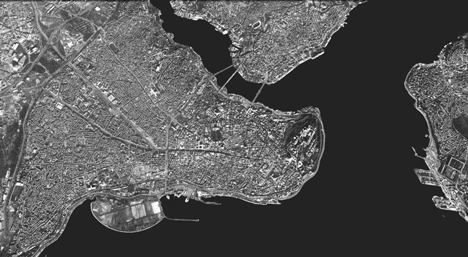
"Protest has been marginalised"
Opinion: the Turkish government's attempt to move protestors from Taksim Square to a new public space – nicknamed the "third testicle" – on a piece of reclaimed land at the edge of Istanbul was a failure from day one, says Justin McGuirk.
On the first of May, demonstrators in Istanbul headed to Taksim Square for the annual May Day rally. On the approach, they were driven back with tear gas and rubber bullets. Since last year's Occupy Gezi protests, Turkish Prime Minister Recep Tayyip Erdogan has banned public gatherings in Istanbul's main square. He hammered home that injunction in a speech in parliament the week before May Day, telling potential protesters, "give up your hope of Taksim".
Nothing about the events two weeks ago was unexpected. Many of the demonstrators were even sporting gas masks and construction helmets, as if the uniform of the Euromaidan protesters in Kiev is now the default garb for protest. Nevertheless, this was not in Erdogan's ideal playbook. After all, his government has gone to the trouble of building a bespoke protest site at Yenikapi, in the south-west of the city, which is many times the size of Taksim. Designed for rallies of up to a million people, this new, official demonstration ground is where the marchers were supposed to converge. Needless to say, on May Day it was deserted.

Picture by Justin McGuirk.
Yenikapi City Park is an extraordinary place. Literally a new piece of the city, it is a 700,000-square-metre landfill reclaimed from the Marmara Sea. This bulbous growth alters Istanbul's cartographic profile, materialising on Google Maps like a tumour on an X-ray. Capacious enough to hold 88 Hagia Sophias, it is larger than all of the city's public spaces combined, and yet many Istanbullu don't even know it exists.
The week before the May Day clashes I was holding a workshop with students at Istanbul Bilgi University. Charged with creating a public awareness campaign about Yenikapi City Park, the students gave it a new name based on its suggestive shape: Üçüncü Billur, the third testicle. Aside from its satirical, schoolboy humour, the nickname fits an official narrative of Istanbul in which progress is measured in thirds: a third airport, a third bridge across the Bosphorus (an obtuse solution to the city’s gridlock) and a third child (to keep the Turkish state young and burgeoning).
Yenikapi City Park is as redundant as a third testicle. And "park" is something of a euphemism. It's true that there are several acres of saplings aligned in neat rows like hair implants, but to reach this greenery the visitor must first cross a desert of concrete – the protest site. On this featureless landscape the sun beats down mercilessly, reflecting back up off the pavers. In its sheer excess of space, it is the very definition of a non-place. Right-minded urbanists who harp on about the value of public space should be careful what they wish for.

In offering Yenikapi with one hand, and taking away Taksim with the other, the municipality is sending the citizens of Istanbul a very clear message. Protest has been marginalised. Banned from the historic and symbolic heart of the city, demonstrations have been shunted to a peripheral site with no history, no context and no symbolic power. While several main arteries meet at Taksim Square, Yenikapi is cut off by a six-lane highway. Not only would demonstrators have to be bussed in, once on the peninsula they can easily be contained by riot police, with nowhere to escape except into the sea. You might call it a bespoke kettle.
Down here in the authorised zone of protest, a crowd can chant as much as it likes, but if the national media decide not to show up then the rest of the city, let alone the country, might not even know – it's worth remembering that during the Gezi Park uprising CNN Türk chose to air The March of the Penguins. In short, while Yenikapi is only a sop to the needs of the citizenry, it suits the authorities perfectly.
In recent years, ceremonial squares in the Tsarist or Soviet mould – Kiev's Independence Square or Cairo's Tahrir Square – have been reimagined by an increasingly global protest movement. Once dour symbols of centralised power have become the new locus in which the distributed power of social networks can become manifest. Long unfashionable, as critic Owen Hatherley has noted, they have become politically correct, romantic, essential.

Taksim Square, designed by the French urban planner Henri Prost in 1939, is not quite in that mould (though Red Square was an early influence) – it is somehow messier, less crisply orthogonal. Yet it has deep associations with union power, and was the site of a May Day massacre in 1977 when police opened fire on demonstrators, which is still commemorated annually.
Yenikapi has no such cultural memory. It is a void, detached from the city. The idea that one can replace Taksim with what might as well be a giant car park on a reclaimed peninsula is not just cynical but brazen. Authoritarianism becomes most apparent when it assumes the pretense of liberalism – when, for example, it only allows the appearance of opposition, or when it tolerates Twitter, just not during an election. In the same way, Yenikapi allows Erdogan to pretend to preside over a healthy democracy while showing all the symptoms of a paranoid despot.
Indeed there is a further irony. The protests over the proposed destruction of Gezi Park last year were also a challenge to the idea of government-led development projects. The solution? Another top-down grand project, a multi-million-dollar land reclamation that benefits no one except the construction industry.
Geographer David Harvey has proposed that the new revolutionaries are no longer the proletariat but urbanites. And as we witness protest becoming a new norm, we are likely to see more governments seeming to encourage it while rendering it toothless. Demonstrations are not meant to be convenient, or fit neatly into authorised zones. To have any meaning, they must spill out into the real and fluid fabric of the city. Beware the bespoke protest site.
Taksim Square image courtesy of Shutterstock.
Justin McGuirk is a writer, critic and curator based in London. He is the director of Strelka Press, the publishing arm of the Strelka Institute in Moscow. He has been the design columnist for The Guardian, the editor of Icon magazine and the design consultant to Domus. His book Radical Cities: Across Latin America in Search of a New Architecture will be published by Verso in June 2014..